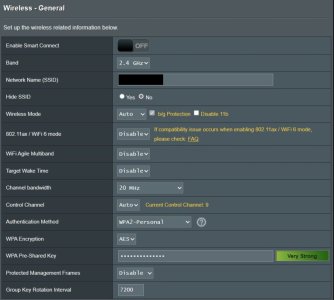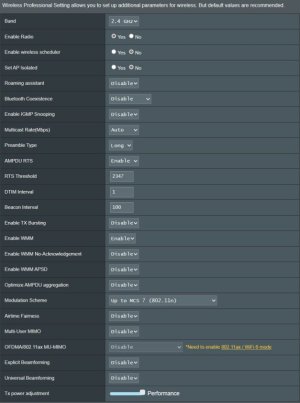aunsafe2015
Occasional Visitor
I have an outdoor surveillance camera (Ring Spotlight Cam) that stretches the range of wifi routers that I've tried. Adding a mesh node closer to the camera is possible, but it would have to be wireless backhaul. I will consider it if necessary, but I want to exhaust all other options first as I prefer to stay with a single wifi broadcasting device for cost and simplicity reasons.
Google Wifi pucks would not connect to the camera at all.
I replaced Google wifi with an AX86U Pro and the camera gets a connection that is decent about 75% of the time (so a massive improvement over Google wifi). Average signal strength reported by the device is RSSI-69. But it completely drops the connection for at least an hour or two per day.
I'm currently testing an AX88U Pro and signal strength is about the same as the AX86U Pro (average RSSI-69 or so). It seems like the camera drops the connection less, so it might be a little more stable, but overall still not as reliable as I'd like.
Attached are screenshots of my 2.4ghz wifi settings. Any recommended changes to try to maximize range? Should I turn on either of the "beamforming" options? These current settings are based on various things I've read on this forum. I have tried manually setting the control channel to 1, 6, and 11 and that did not seem to improve anything. USB is set to 2.0 and nothing is connected to the USB port.
Also, is there any reason to think that the GT-AX6000 might be an improvement over the AX88U Pro for 2.4 ghz range purposes? I'm still within return period and could try out an AX6000 if there's a chance it would be better.
Edit: I'm currently running the 3.0.0.4.388.23110 firmware.
Many thanks for any input!
Google Wifi pucks would not connect to the camera at all.
I replaced Google wifi with an AX86U Pro and the camera gets a connection that is decent about 75% of the time (so a massive improvement over Google wifi). Average signal strength reported by the device is RSSI-69. But it completely drops the connection for at least an hour or two per day.
I'm currently testing an AX88U Pro and signal strength is about the same as the AX86U Pro (average RSSI-69 or so). It seems like the camera drops the connection less, so it might be a little more stable, but overall still not as reliable as I'd like.
Attached are screenshots of my 2.4ghz wifi settings. Any recommended changes to try to maximize range? Should I turn on either of the "beamforming" options? These current settings are based on various things I've read on this forum. I have tried manually setting the control channel to 1, 6, and 11 and that did not seem to improve anything. USB is set to 2.0 and nothing is connected to the USB port.
Also, is there any reason to think that the GT-AX6000 might be an improvement over the AX88U Pro for 2.4 ghz range purposes? I'm still within return period and could try out an AX6000 if there's a chance it would be better.
Edit: I'm currently running the 3.0.0.4.388.23110 firmware.
Many thanks for any input!
Attachments
Last edited:



